| Programme of Study statements |
Activity |
| A |
B |
C |
D |
| Recall multiplication and division facts for multiplication tables up to 12 × 12. |
|
|
|
|
| Use place value, known and derived facts to multiply and divide mentally, including: multiplying by 0 and 1; dividing by 1; multiplying together three numbers . |
|
|
|
|
| Recognise and use factor pairs and commutativity in mental calculations. |
|
|
|
|
| Multiply two-digit and three-digit numbers by a one-digit number using formal written layout. |
|
|
|
|
| Solve problems involving multiplying and adding, including using the distributive law to multiply two digit numbers by one digit, integer scaling problems and harder correspondence problems such as n objects are connected to m objects. |
|
|
|
|
Activity Group A
Year 4 Statutory requirement: Recall multiplication and division facts for multiplication tables up to 12 × 12
Last Digit Patterns – A ‘Teachers’ TV’ activity

Generating and using last digit patterns to explore and create patterns in a ‘clock face’. Fantastic activity for practising times tables facts, predicting and reasoning as to why some times tables share the same patterns on the ‘clock’.
12 x 12 Grid Patterns – Exploring arrays, multiples and factors
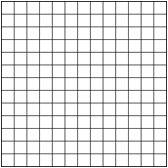
Resources required: Blank 12 x 12 (half or a whole sheet of A4) grid and write in numbers 1-12 along the horizontal and vertical to create a multiplication grid.
Start with a number such as 12 and use cubes to create all of the possible arrays (e.g. 1 x 12, 12 x 1, 2 x 6, 6 x 2 etc) Place these cube arrays in the multiplication grid to show that 2 x 6 = 12 because we have a 2 by 6 array and therefore 12 cubes. Children can see that the 2 x 6 array could be 2 across and 6 down or 6 across and 2 down etc.
Now we should be able to place a cube everywhere 12 would be on the 12 x 12 grid. How many 12’s will there be and why? Do you notice anything about where the cubes are when you’ve finished? Can you explain why this is? (Commutative Law)
Repeat this with other numbers and focus upon predicting where the cubes will be placed and reasoning why e.g. How many times will ‘7’ appear on this grid and why? Will it be more or less times than 12?
Explore larger numbers such as 24 where two of the factors will not appear on this particular grid (1 x 24 and 24 x 1) ask the children to discuss which factors won’t appear and why and how they can use the factors of numbers like 20 to determine the factors of 40 and 80 etc.
Linking Division and Multiplication Facts Quiz
Children work in pairs.
Ask children to choose a times table to practice e.g. 7. One child writes down a vertical list of multiples of this number (up to and beyond 12 x 12 to apply partitioning skills when appropriate)
Version 1: Child passes this list to partner and asks them to say how many 7’s are in this particular multiple. Their partner must explain how they are working it out (if it is not a known fact) and emphasis is placed upon efficient use of known facts to generate derived facts e.g. ‘Well I know that 5 x 7 is 35 so 6 x 7 will be 7 more so that’s 42’.
Version 2: Child passes paper over and partner works against the clock. Jottings are allowed (and encouraged) whilst working with more challenging multiples.
Complete the multiplication grid using cut out interactive ‘jigsaw’ pieces
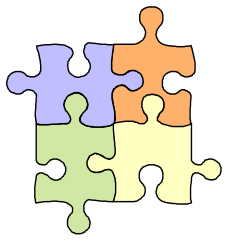
Activity Group B
Use place value, known and derived facts to multiply and divide mentally, including: multiplying by 0 and 1; dividing by 1; multiplying together three numbers
Multiplying and Dividing with Straws
Resources required: Straws in bundles (see below)
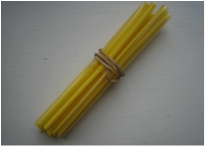
Give children straws which have been halved and ask them to bundle them into single colour groups of 10. Then bundle 10 groups of 10 to form hundreds. Create sets of hundreds, tens and units straws for pairs of children to use. (These are an excellent resource for teaching columnar calculation methods and other aspects of place value and fractions too, so well worth making).
Look at a series of calculations such as 6 x 3, 60 x 3 and 600 x 3. Ask children to talk about what this calculation means and model it using their bundles of straws. Discuss in pairs and small groups what they have found out and reason why the patterns they are seeing exist.
Ask children to create their own series of calculations and model them using straws.
Ask children to generalise the rules regarding multiplying by 1, 10 and 100 and apply this to other calculations of their own creation. If ‘add a zero’ comes up in discussion explore what would happen if the zero/s were not there and help children see zero as a ‘place holder.’
Use straws to repeat activity but using division by 1, 10 and 100.
Use straws to explore multiplying and dividing by 0 and discuss what happens and why.
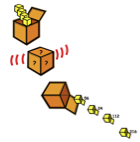
What has the large box multiplied the numbers by to get the numbers which come out at the end? (And just to get us really thinking….we don’t know what the numbers were that went in at the beginning: only those that came out after they’d been multiplied!)
Activity Group C
Year 4 Programme of Study: Recognise and use factor pairs and commutativity in mental calculations
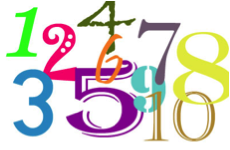
48 is called an abundant number because it is less than the sum of its factors (without itself). Can you find some more abundant numbers?
A game which helps children derive, practise and use their knowledge of factors and multiples. Can you block your opponent?
Sports Practice

Work in pairs and use cubes or counters to explore and build mathematical models and support conjecture.
Your teacher is running an after school club. Some weeks the number of children who turn up make it really easy to divide everyone up into equal groups for all different kinds of games. Some weeks the number of children who turn up makes it almost impossible!
Explore which totals would make life easier and which would cause problems. Explain why some numbers are ‘better’ than others in this context. Explore models which show all of the possible solutions and link this to arrays, commutability, square numbers, prime numbers and factor pairs. Explore which totals have an odd number of factors and explain why. Use explorations to predict which larger numbers could be divided in many ways and which would cause problems.
Activity Group D
Year 4 Statutory requirement: Solve problems involving multiplying and adding, including using the distributive law to multiply two digit numbers by one digit, integer scaling problems and harder correspondence problems such as n objects are connected to m objects."
Resources required: Interlocking cubes or straw bundles (see activity group A)
Build 14 x 4 using cubes (14 multiplied 4 times)
Ask children how they would calculate this total. Most likely response is 10 x 4 = 40, and 4 x 4 = 16. Then 40 + 16 = 56
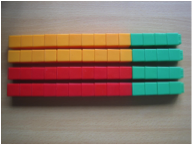
Record this model as a grid to link children’s method and use of distributive law to multiply 2 -digit by 2-digit numbers.
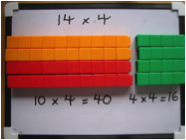
Use straw bundles to make 124 x 3. Record model as a grid to show use of distributive law to multiply 3- digit by 2-digit.
Repeat these activities and similar activities using place value counters (see video below) instead of cubes/dienes and straw bundles.
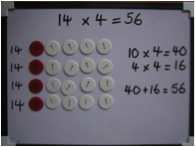
Using grid method as a formal written method Lower Key Stage 2 NCETM video: Using manipulatives (place value counters)
Real-life Connections: Regularly link these calculations to real life, meaningful problems relating to familiar situations such as shopping and cooking. For example:
My brother is working part time in the supermarket in the evening stacking shelves. He needs to stack the boxes 7 high and 15 across. How many boxes will he need?
The people in the stadium are sitting in rows of 36 and there are 9 rows in each sections. What is the capacity of each section? If there are 40 sections in the stadium what is the total capacity? (Using multiplication by 10 as well as grid method).
(See also upper Key Stage 2 video moving from grid method to formal written method – 2- digit by 2-digit long multiplication)
Upper Key Stage 2 NCETM video example discussing grid method and its relationship with long multiplication
EWWNP means Exploring Wild and Wonderful Number Patterns Created by Yourself! Investigate what happens if we create number patterns using some simple rules.
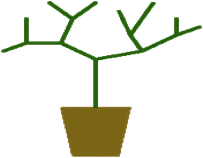
Can you work out how many flowers there will be on the Amazing Splitting Plant after it has been growing for six weeks?
Find the recipe proportions needed by scaling up the ingredients.

Can you work out how to scale the recipe to make ‘Snape Sponge’ for everyone?

Use the data to describe the journeys as proportions of each other e.g. Norwich to Cambridge is 105 km and Norwich to Oxford is 272 km so we could say that the first journey is just over a third of the second and the second is approximately two and half times further.
Use a mapping website to research distances which have greater meaning to the children and make similar comparisons using appropriate written methods to justify answers.
(Also use this activity for other areas of maths such as difference)
Sports Mega-Facts
Research the capacity of sports stadia around the world and link to geography to locate on a world map. Collect as data and make comparisons as above in terms of fractions and scaling.
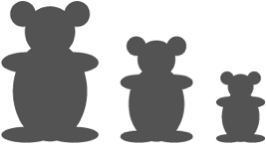
Can you work out the height of Baby Bear's chair and whose bed is whose if all the things the three bears have are in the same proportions?
Useful Resources
- Interlocking cubes
- Place value counters
- Counters
- Blank 12 x 12 grids
- Straws
- White boards and pens













